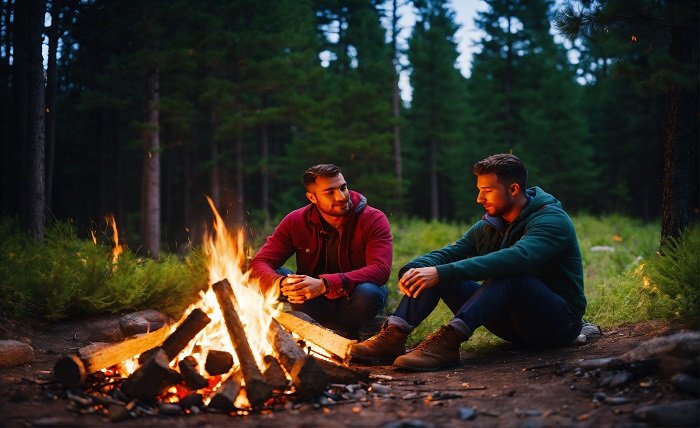Healing and Growth Through BlueFire Wilderness Therapy

Wilderness therapy has emerged as a powerful and transformative approach to addressing the mental health and behavioral challenges faced by adolescents and young adults. Among the leading programs in this field is BlueFire Wilderness Therapy, a program that has gained attention for its innovative approach and success in helping individuals reconnect with themselves, others, and the natural world. In this blog post, we will explore the benefits, process, and philosophy behind BlueFire Wilderness Therapy, shedding light on how it can help struggling youth overcome obstacles and pave the way for a brighter future.
What is BlueFire Wilderness Therapy?
BlueFire Wilderness Therapy is an outdoor-based therapeutic program designed for adolescents and young adults who are dealing with mental health, emotional, behavioral, and academic challenges. The program integrates traditional therapeutic methods with outdoor adventures to help individuals work through their issues in a supportive, structured environment.
The core of the bluefire wilderness Therapy program is the belief that nature, in all its beauty and challenges, offers a unique space for personal growth. Participants engage in outdoor expeditions, therapeutic activities, and group discussions, all guided by experienced therapists and field staff. These activities aim to foster personal reflection, teamwork, self-awareness, and emotional resilience.
Incorporating elements of cognitive-behavioral therapy (CBT), dialectical behavior therapy (DBT), and experiential therapy, BlueFire Wilderness Therapy focuses on building coping skills, emotional regulation, and healthy communication. The wilderness environment acts as a catalyst for change, allowing participants to disconnect from the distractions of everyday life and immerse themselves in an experience of self-discovery and healing.
The Benefits of BlueFire Wilderness Therapy
BlueFire Wilderness Therapy offers a multitude of benefits to individuals struggling with various challenges, including substance abuse, depression, anxiety, trauma, and behavioral problems. Through structured wilderness expeditions, participants gain valuable life skills that promote emotional growth, self-regulation, and personal empowerment.
One of the main advantages of the BlueFire Wilderness Therapy program is the holistic approach it offers. Rather than focusing solely on mental health, the program addresses the physical, emotional, and psychological well-being of participants. The wilderness provides a unique opportunity for self-reflection, physical activity, and social interaction—all of which contribute to improved mental health and well-being.
Additionally, BlueFire Wilderness Therapy helps young people gain a sense of independence and responsibility. Through the challenges posed by the wilderness setting, participants develop resilience, teamwork, and problem-solving abilities. They learn to navigate difficult situations, work collaboratively, and persevere in the face of adversity—all skills that will serve them well long after their therapy sessions end.
The Therapeutic Process at BlueFire Wilderness Therapy
The therapeutic process at BlueFire Wilderness Therapy is designed to guide individuals on a journey of self-discovery and healing. From the moment they arrive, participants are introduced to a supportive and structured environment that fosters trust, personal growth, and accountability.
Upon arrival, participants engage in an assessment with a licensed therapist, who works with them to develop an individualized treatment plan tailored to their specific needs and goals. This plan incorporates both therapeutic sessions and outdoor activities designed to promote personal growth. Over the course of the program, participants will engage in group therapy sessions, one-on-one therapy with their primary therapist, and experiential activities designed to challenge their thinking and behavior.
Through the combination of therapy and wilderness experiences, participants are able to develop new coping mechanisms, build stronger relationships, and gain insight into their emotional and behavioral challenges. The wilderness setting is intentionally used as a tool for therapeutic growth, encouraging participants to disconnect from technology, reduce distractions, and focus on the present moment.
How BlueFire Wilderness Therapy Helps Adolescents and Young Adults
bluefire wilderness therapy is specifically designed to help adolescents and young adults who may be struggling with various issues such as mental health disorders, behavioral problems, academic difficulties, and substance abuse. The wilderness setting provides an opportunity for these individuals to engage in therapy outside of a traditional clinical environment, which can be more effective for some individuals who may feel disconnected or resistant to traditional therapeutic approaches.
By taking participants out of their familiar environments and placing them in a challenging yet supportive setting, BlueFire Wilderness Therapy encourages growth, self-awareness, and emotional regulation. The program focuses on helping individuals develop healthier coping strategies, improve their communication skills, and learn how to manage their emotions in more constructive ways.
Furthermore, BlueFire Wilderness Therapy is designed to promote positive peer relationships. In a wilderness setting, participants are encouraged to work together, support one another, and engage in group activities that foster a sense of camaraderie and trust. These positive relationships can play a crucial role in promoting long-term healing and growth.
The Role of Nature in BlueFire Wilderness Therapy
Nature plays an integral role in BlueFire Wilderness Therapy. The program utilizes the wilderness as both a therapeutic tool and a source of inspiration. Immersing participants in the natural world allows them to step outside of their everyday routines and distractions, creating a space where they can reflect on their thoughts, emotions, and behaviors without the usual external pressures.
The therapeutic benefits of nature are well-documented. Spending time in nature has been shown to reduce stress, improve mood, increase mindfulness, and promote overall well-being. These benefits are particularly valuable for individuals struggling with mental health or behavioral issues, as nature provides a calming, restorative environment that can help regulate emotions and reduce anxiety.
At BlueFire Wilderness Therapy, participants engage in a variety of outdoor activities, such as hiking, backpacking, and camping, which help them build resilience, problem-solving skills, and teamwork. These activities challenge participants physically and mentally, promoting personal growth and fostering a sense of accomplishment.
Family Involvement in BlueFire Wilderness Therapy
An essential component of the BlueFire Wilderness Therapy program is the involvement of family members in the therapeutic process. Family therapy plays a critical role in addressing the underlying issues that may be contributing to the participant’s struggles. By involving family members in therapy, the program helps to heal relationships and promote understanding.
Throughout the program, families are encouraged to participate in regular check-ins with their loved ones, receive updates from therapists, and engage in family therapy sessions. This collaborative approach allows family members to gain insight into their loved one’s experiences and provides them with tools and strategies to support their loved one’s ongoing recovery.
Family involvement is crucial in ensuring the long-term success of the therapy. By addressing familial dynamics and improving communication, BlueFire Wilderness Therapy helps participants build stronger, healthier relationships with their family members, which can be an essential part of their overall healing process.
Success Stories: Real-Life Impact of BlueFire Wilderness Therapy
The success of BlueFire Wilderness Therapy is evident in the stories of the many individuals who have experienced transformation through the program. Participants who have struggled with mental health issues, substance abuse, and behavioral problems have found hope, healing, and personal growth through the therapeutic process.
Through their time in the wilderness, many participants have developed healthier coping strategies, improved communication skills, and learned how to regulate their emotions more effectively. These changes have had a lasting impact on their relationships, academic performance, and overall well-being.
One success story involves a young adult who had been struggling with depression and substance abuse. After participating in BlueFire Wilderness Therapy, they gained a sense of self-worth, built resilience, and developed healthier coping mechanisms. Today, they are living a successful, fulfilling life and have maintained their recovery.
The program’s combination of therapy, outdoor adventures, and family involvement has proven to be an effective formula for lasting change, and the success stories continue to highlight the life-changing impact of BlueFire Wilderness Therapy.
Conclusion
BlueFire Wilderness Therapy offers a transformative approach to healing and personal growth for adolescents and young adults who are facing a variety of challenges. Through a combination of therapeutic techniques, outdoor activities, and family involvement, participants are given the opportunity to reconnect with themselves, their peers, and their families. By immersing participants in the healing power of nature, BlueFire Wilderness Therapy helps individuals overcome obstacles, develop coping skills, and pave the way for a brighter future.
If you or someone you know is struggling with mental health, substance abuse, or behavioral challenges, BlueFire Wilderness Therapy may provide the support and guidance needed to embark on a journey of healing and transformation.
FAQs
- What is the age range for participants in BlueFire Wilderness Therapy? BlueFire Wilderness Therapy is designed for adolescents and young adults, typically between the ages of 11 and 18, but the program also accommodates young adults up to age 28.
- What types of mental health issues does BlueFire Wilderness Therapy address? BlueFire Wilderness Therapy helps individuals with a range of mental health issues, including depression, anxiety, trauma, substance abuse, and behavioral challenges.
- How long does the BlueFire Wilderness Therapy program last? The length of the program varies depending on the participant’s needs, but it generally lasts between 6 to 8 weeks.
- Is BlueFire Wilderness Therapy covered by insurance? BlueFire Wilderness Therapy may be covered by insurance, depending on the individual’s plan. It is important to contact the program’s admissions team to verify coverage.
- How do family members get involved in the BlueFire Wilderness Therapy process? Family involvement is an essential part of the BlueFire Wilderness Therapy program. Families are encouraged to participate in family therapy sessions, regular check-ins, and receive updates on the participant’s progress.


